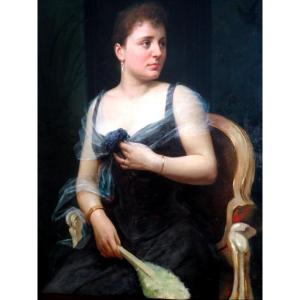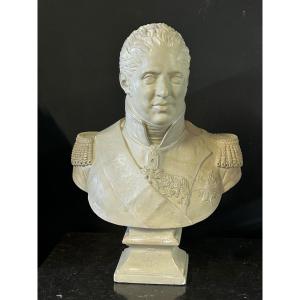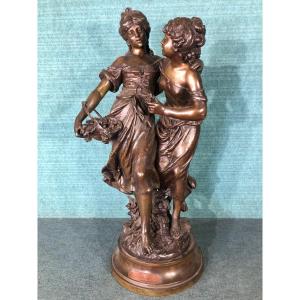Dijon November 18, 1822
Paris February 14, 1912
Singer of female grace, his figures, genre scenes and allegories, of amiable and smiling realism, dominate a very abundant production of collection bronzes to which are added many official commissions. Son and student of Jean-Baptiste Moreau, he entered the Paris School of Fine Arts at the age of nineteen where he studied under the direction of Ramey and Dumont. He won the second prize in Rome in 1842 with Diomedes removing palladium and appeared for the first time at the Salon in
1848; he will obtain many honours there. To
In 1850, he worked for the Val d'Osne foundry, of which he became one of the administrators and to which he provided models for cast iron statues.
Mathurin Moreau's work includes memorials, tombs, many statues and busts of personalities, ornamental sculptures. He works for the Saint-Augustin and Trinity churches, for the Opera, the Palace of Justice, the City Hall, the Tuileries, the Marsan Pavilion at the Louvre, the Gare du Nord, one of the fountains of the Place du Théâtre Français (statue of the Nymphe fluviale), etc. But his work also includes a large number of statues, statuettes and groups on pleasant and decorative themes that were then with considerable success.
At the Salon, Mathurin Moreau sends quite a few bronzes: The Flower Fairy, a 140 cm high group
(1853), L'Etude et Fileuse (1859), La Meditation (1861), Le Printemps (1865), Primavera (1872), Circe, statuette
(1873), Ismaël et Candeur, deux bustes (1875), Rêverie, statuette (1883), Protection de l'enfance (1892), Les Armes d'Achille (1898), Le Torrent (1901), Marguerite d'Anjou, group for the monument of Angers and Gramme, Belgian electrician, statue for his tomb at Père-La-chaise (1902), Le Rêve et Gloire au travail (1903), finally Four statuettes: La Mutualité et Fleuve (1906), Première Fleur (1907), La Source de jouvence (1909). In terms of statuettes and small marble groups, it should still be noted: Baigneuse (1876), Phryné (1878), La Vigneronne
(1884), The Wave (1887), Joan of Arc (1891), Girl in the Vasque (1894), Bathing trip (1899), Youth
(1905), Passage of the ford (1911).
Most of these works and many others not exhibited at the Salon were published in bronze by different foundries as evidenced by the pieces on the market or preserved in museums. However, it is difficult to identify them because of the great fantasy that reigns about their designation. However, let us point out some editions made by Susse:
The Charmeuse, 82, 66 and 55 cm.
Girl at the fountain, 100, 80 and 65 cm.
The Spring Awakening, 83, 65 and 55 cm.
The Source, flat, L. 46 cm.
Youth triumph, 85 cm.
We also know bronzes drawn by E. Colin (Reap-neuse, 50 cm, Young girl sitting, 73 cm), by Godeau (Young naked woman sitting, 48 cm), by Berneaux (Woman carrying a hood, 50 cm), etc.
MUSEUMS
Caen
La Fileuse, 130 cm (Victor Paillard, bronzer in Paris, 1862).
Dijon
Self-portrait, medallion, diameter 26 cm.
The Exiles, 39 cm.
The Fairy with the flowers, 146 cm (Gonon; Salon of 1853).
Woman holding an olive branch, 33 cm.
Funeral figure holding an hourglass, 33 cm.
Funeral genius, 32 cm.
Ishmael, bust, 75 cm.
















































 Le Magazine de PROANTIC
Le Magazine de PROANTIC TRÉSORS Magazine
TRÉSORS Magazine Rivista Artiquariato
Rivista Artiquariato